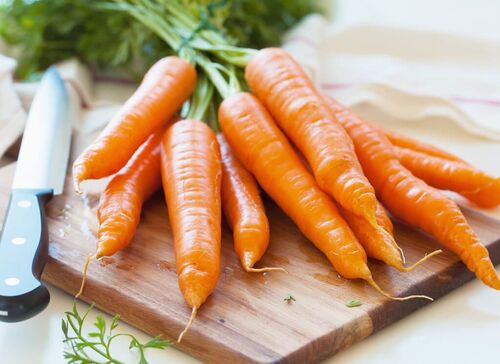Growing Carrots

Carrots are a healthy vegetable, easy to grow and the best part is that you can do it yourself!
Check out the different kind of carrot seeds >
Grow your own carrots
If you've never eaten home-grown carrots, you're really missing out. Freshly harvested carrots taste delicious and so much better than any carrot you've ever eaten before.
The slightly sweet and 'earthy' taste is fantastic. You don't need a vegetable garden or large backyard to grow carrots. Anyone can grow this easy vegetable in a large or small garden.
Health benefits
Aside from it's great taste, carrots provide numerous health benefits. One of the benefits of carrots is to a vital organ in the body: the eye. Carrots contain vitamin A which helps to improve eyesight and is especially essential for night vision. Carrots help the liver to flush out toxins from the body, and reduces the amount of bile and fat in the liver. They help protect the heart from oxidative impairment, plaque formation and grave cholesterol boost. Carrots are a good source of calcium which helps with bone development and maintenance.
The list of the health benefits of carrots is endless as it contains almost all the necessary vitamins vital for proper growth and development.
Sowing carrots
In the ground, within raised beds or on the patio in containers – carrots can be grown just about anywhere. Carrot seed should be sown directly in the garden or container. Sow the seeds as thinly as possible, 1cm (½in) deep, in rows 15–30cm (6-12in) apart. Thin out seedlings if necessary. If you have room for a few rows, choose a type of summer carrot. They will give you the sweetest carrots you've ever tasted! For a summer harvest, sow seeds outdoors 3 to 5 weeks before the last spring frost date.
How to harvest carrots
You can harvest the summer carrots from July to October and the winter carrots from October to November. A way of telling that your carrots are ready to harvest is by looking at the diameter of the carrot. If it is between ¾ to an inch in circumference, they are ready to pull (depending on the variety). Grabbing the foliage and giving it a pull often results in a handful of foliage with no carrot attached. It helps to loosen the soil with a garden fork before harvesting carrots. The advice is to eat the carrots shortly after harvesting.
Growing carrots in the garden
The best way to grow carrots is to sow the seeds directly in the garden / container. There are also seed ribbons. This is a ribbon of organic material, in which the seeds are contained. By making use of this all you have to do is put the ribbon on the ground and cover it with some soil. Then the roots will always grow at the right distance and they will not get in each other's way during growth.
Growing carrots in a container
It is also possible to grow carrots in a container. Paris market carrots are ideal for growing in containers and windowboxes. The Parisian carrot is a little round carrot that is a nineteenth-century French heirloom! This carrrot variety is an early orange-red carrot that grows like the shape of a large radish. The short roots also cope well with clay soils where other carrots struggle. Other varieties can also grow in a container but then you will need a minimum depth of about 25cm.
Sowing carrots step by step
- Sow the carrot seed thinly in shallow trenches at a depth of 6-8 mm, in sandy or well-loosened soil.
- Mix the seeds with fine sand and sprinkle the mixture into the trenches. Then cover them with a thin layer of soil or compost.
- If using containers, sow thinly on the surface of the soil, then cover the seeds with 3 to 4 mm of fine soil.
- Keep the soil moist but not wet and free of weeds.
- Sow a row every week or two to extend the harvest season.
- Remove weeds as the plants grow, so that the carrots have plenty of room to grow.
- Depending on growing conditions, you can harvest 2-3 months later. You can easily harvest the carrots by loosen the soil with a garden fork and pulling them out of the ground.
Tips for sowing carrots
- The seeds are small, so be careful not to sow them too close together.
- Carrot seed germinates slowly and it can take seven to twenty-one days. Keep an eye on them and cover the tops of the carrots with soil to keep them from turning green.
- Leave some carrots in the soil at the end of the season. The following year they will flower and provide an excellent food source for insects.
Carrot fly
If the carrot fly is a problem in your area (ask the people who are already growing carrots), you better choose a resistant variety or sow carrots at the end of May, when the carrot fly has disappeared. An alternative is to cover your plants with a insect net. It will prevent the fly from getting in and start laying eggs.
Different colors of carrots
Did you think carrots were always orange? Wrong! carrots were originally white, but did you know that there is an entire rainbow of carrot colors! Like purple, yellow, white, light pink, and then there are the shapes: grow your own round carrots (Paris market carrots), short thick carrots, or carrots that are so big that you can immediately invite a lot of guests for dinner. All shapes and sizes are possible, and they often grow in very strange curves as the roots grow underground.



